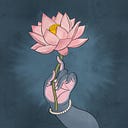Goddess Bagalamukhi
Description of the iconography of Bagalamukhi from the Mantramahōdhadi of Mahidhāra (10.5):
sauvarṇāsanasaṃsthitāṃ trinayanāṃ pītāṃśukollāsinīṃ
hemābhāṅgaruciṃ śaśāṅkamukuṭāṃ saccampakasragyutām |
hastair mudgarapāśavajrarasanāḥ saṃbibhratīṃ bhūṣaṇair
vyāptāṅgīṃ bagalāmukhīṃ trijagatāṃ saṃstambhinīṃ cintayet ||
“One should think of Bagalāmukhi, who is on a golden throne, has three eyes, is shining in a yellow garment, whose body is golden-hued, who bears the moon on her crown, is endowed with a garland of excellent campaka flowers, holds in her hands a mace, a noose, a thunderbolt, and an (enemy’s) tongue, whose body is adorned with ornaments and who paralyses the three worlds.”
Goddess Bagalāmukhi (lit. crane or heron-faced; from sanskrit baka) is one of the Daśamahāvidyas. Though none of her dhyānas describe her as having the head of a crane, in images, she is found at times with the head of a crane and sometimes without. Balākā, the crane, is also the name of one of the sixteen śaktis surrounding the Goddess in her yantra. The Tantrasāra describes Her as having a complexion of a golden yellow, with a gadā (mace) in one hand and holding a demon by his tongue in the other hand. She has three eyes and sits in padmāsana on a throne placed on a bejeweled platform inside a pavilion in the middle of an ocean of nectar. Her garments are yellow, she is adorned with golden ornaments and yellow flowers (generally champaka flowers) and a yellow crescent moon adorns her forehead — pītāmbarābharaṇa mālya vibhūṣitāngi. She is therefore known as Pītāmbari, as, according to one of her origin stories, she arises out of a lake of turmeric. The worshipper is benefitted by worshipping her while clad in yellow garments and performing a japa of her mantra with beads of turmeric. The significance of her yellow color is its representation of a radiant, cleansing energy that overcomes darkness — the Vedas speak of a golden light hiraṇya varṇa emanating from the Supreme truth satya.
“O Mother, the power of stopping all things in the microcosm and macrocosm is your single great power as Bagala.”
Ganapati Muni, Umasahasram
‘Bagala’ can also mean a rope or a bridle (from valgā), referring to her hypnotizing power to stun or control. A demon called Madan once undertook austerities and was conferred with the boon of vāk siddhi, by virtue of which anything he said would come true. Predictably, he abused this power, and the Gods, enraged by his deeds, worshipped Bagalamukhi. She ceased the demon’s rampage by grabbing hold of his tongue and stopping his rampage. Before she could kill him, however, he asked to be spared and begins to worship the Goddess. Her power to stun the actions of enemies is stressed, and She is propitiated for this purpose. Bagalamukhi is also invoked when a worshiper wishes to gain possession of or control over another person or spirit.
Bagalamukhi is said to be the bestower of vāk sthambhanakāri, the power of paralysing the enemy’s speech. When the brilliance of speech shines forth, it puts the egotistic word to rest, and fittingly, she is worshipped for success in debates. Bagala bestows a power of speech that silences — due to the irrefutable nature of ultimate truth. Her mantra requests the goddess to silence the enemy by “nailing the tongue”, and the enemy’s tongue is also one of the attributes in her hands. She is thus known as bakamukhi, one who makes the opponent duck-faced. In Indian literature, the swan has the proverbial faculty of separating water from milk is a symbol of critical acumen, while the duck is an incessantly quacking symbol of stupidity. Bagalāmukhi is capable of making a swan of an opponent into a duck.
She is a path to self-enquiry that leads to the perception of Brahman — the highest form of spiritual realization that puts an end to all uncertainty and ignorance. Bagala is speech personified, which is used as a weapon to destroy all negativity and hostility born of the ego. She represents the rite of immobilization, sthambana, a paralyzing force that creates a yogic stillness that arises out of self-awareness and mastery over our own thoughts and actions. She has temples dedicated to Her across the country, including in Hoshangabad (Madhya Pradesh), Kashmir, Dalhousie, Hyderabad, Uttarakhand, Assam, Himachal Pradesh (where priests of the ruling family in Mandi are reported to have been her followers) and in Patan, Nepal.
“Impeded by thy resisting power, the loquacious become dumb, the lord of the earth becomes a lowly pauper, fire turns cold, the angry are appeased, the wicked turn good, the fast trotter limps, the arrogant is humbled, the all-knower becomes an ignoramus, O Bagalāmukhi, the eternal auspicious mother, daily our obeisance is to thee.”
References:
- The Ten Great Cosmic Powers by S. Sankarnarayanan
- The Iconography of Hindu Tantric Deities, Vol I: The Pantheon of the Mantramahodadhi by Gudrun Bühnemann
- Tantric Yoga and the Wisdom Goddesses, Dr. David Frawley
- Hindu Religion and Iconology According to the Tantrasāra by Pratapaditya Pal
______________________________________________________________
If you find value in my work, I hope you consider becoming a patron through Patreon. Hindu Aesthetic requires a lot of time and effort and your support would mean that I can continue bringing you the highest quality content.
